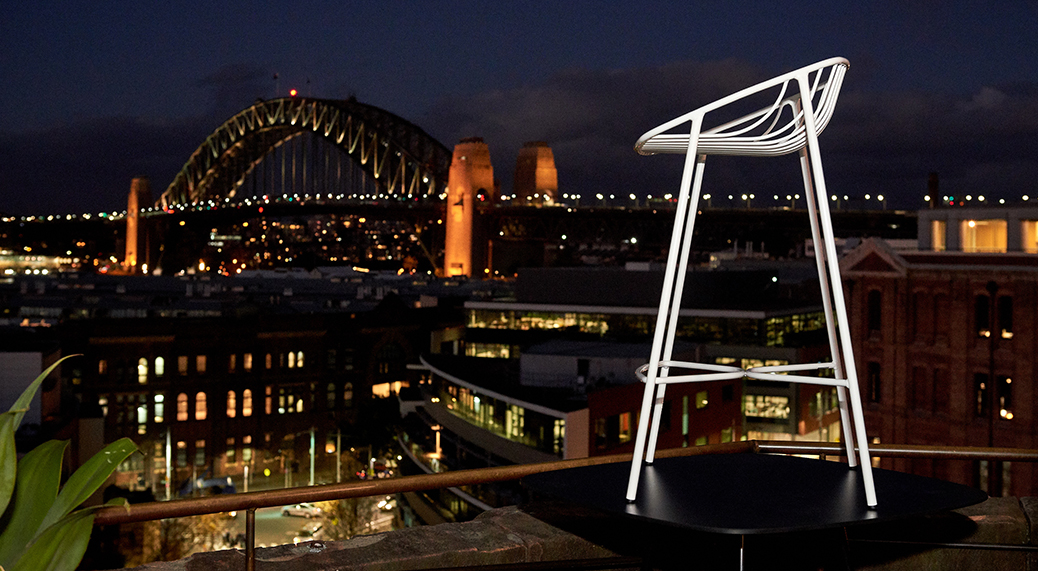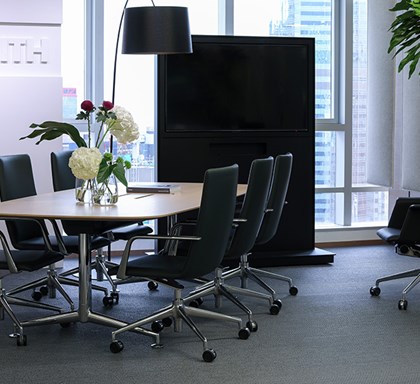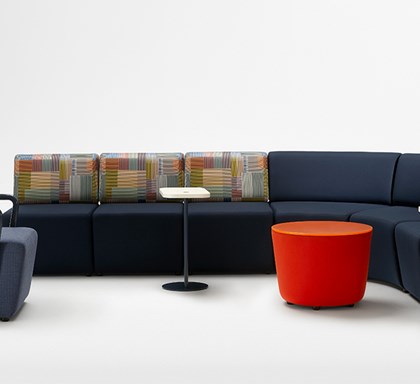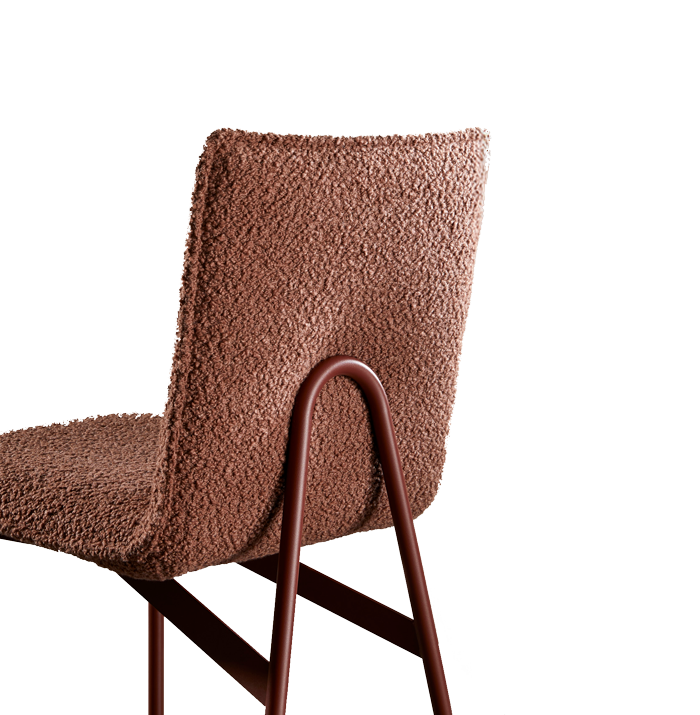In the lead up to his launch of Pino for Zenith, we sat down with Keith Melbourne to get a behind the scenes glance of the designer at work.
It has been said before, and yet I will say it again. Keith Melbourne has carved out a unique place for himself in the world of contemporary design. Exploring the sometimes twin, sometimes twain, virtues of rational engineering and creative design, his work bears an unmistakable signature: highly resolved end-results that appear equally whimsical and graphic, but soon start to reveal a litany of calmly determined design choices to bestow the invisible comforts of everyday life.
Having recently launched his latest collection – Pino – for Zenith, it is clear that the union of engineering, manufacture, R+D and creative design continues to be a strong driving force for Melbourne. Across the entire range, comprising wire-work dining and lounge chairs, stools, and accompanying tables, Pino carries a sometimes surprising back history that Melbourne was kind enough to share:

Pino Stool by Keith Melbourne
It has been said before that your engineering background heavily influences your work. I was wondering, however, whether your background in aerospace and automotive engineering also influences it more directly?
Keith Melbourne: That’s a good question. I don’t think that it is directly influenced by aerospace and automotive engineering as much as it is by manufacturing. I work with manufacturers to refine the design of the product and pre-empt moments where we can refine the product (as an end result) and the process of its manufacture. The aesthetic … well, maybe I’m not the best person to judge!
[laughs]. No not, really?
Keith Melbourne:[laughs] Ah, well no not really. But I do think that in terms of aesthetic, Pino has so many lines and in that way it is almost like drawing. The different lineweights express the product in a different way. So we start with much finer seating wires that hang in a frame, and these lineweights add more definition to the product. So in terms of its aesthetic influences, I’d have to say it’s the precision I choose to work with … You can take the boy out of engineering, I guess!

Pino Dining Chair by Keith Melbourne
And is that quite common for your work process? Designing functionally first, and then aesthetically second? Or are they constantly intertwined for you?
Keith Melbourne: Definitely intertwined. But having said that, I’m a strong believer in the functionality of products. So much time on this product was spent trying to perfect its comfort. I was adamant that although it is essentially a wire chair, it should be as comfortable as possible for its category type. So I spent a lot of time reworking the distribution of load over the wire seat, minimising or eliminating pressure points that lead to discomfort. I always start with thinking about the functionality and comfort of each piece, and then rework elements of its aesthetic dimension – so they are very intertwined.
So when you began with the functionality and comfort of Pino, what was its initial seed?
Keith Melbourne: Well the very first part of the design journey for Pino is this softened hexagonal hoop that forms the seat and back of the chair. That’s the distinctive feature of the chair – it screams out at you from the other side of the street. The wires that hang from the hoop almost forge a sling shape – very soft, and very surprising given the hardness of the material. Right from day one, the key features of the product were still there, and they really did determine the direction and the editing throughout.

Pino Lounge Chair by Keith Melbourne
When I sat down with the other editors in the office, we were refreshing our memories of your recent work for brands like Stylecraft and Zenith, and the one thing that really jumped out at us was the strong graphic nature of your portfolio
Keith Melbourne: That’s interesting because if I had to choose only one word to describe my work it would have to be ‘line’. How line in the 2D and the 3D form then translates into a sculptural presence. I obsess over it, really. Complex lines and vital lines are a central theme in my work. So when you recognised the graphic nature of what I do, you’re right on the money!
[laughs] So you feel that Pino is very harmonious with your previous collections?
Keith Melbourne: I do, yes. Well … actually, that’s a difficult question.
Well, do you feel then that Pino offers something new and slightly divergent from your back history of work?
Keith Melbourne: In a way, yes. For the dining chair in particular, I hadn’t tackled that type of product before – let alone in wire! I’ve done a lot of upholstered furniture and soft seating and stools, but for me I would nominate Pino as ‘hard’. One of the main challenges (which, in a way was more pleasurable than frustrating) was the fact that when you work in wire, everything is on display. The ergonomics, the aesthetics, you can’t hide anything! By sculpting the piece to achieve comfort, you’re radically changing the sculptural form of it at the same time.
Well on that, Pino has this sense – at least to me – of wearing its heart on its sleeve (if such a thing could be said of a wire chair…) –
Keith Melbourne: [laughs]

Keith Melbourne showcasing Pino
And I have a feeling that this comes from its very flexible nature. Not only is it appropriate both indoors and out, but I can see it being equally at home in residential, commercial and even hospitality environments. It’s equally casual as it is formal. Was this versatility something very much at the centre of your design intent?
Keith Melbourne: Yes – and I viewed it particularly while I was developing the chair, as ‘a chair’ not ‘an outdoor chair’, for instance. I wanted to develop it to a level of comfort and aesthetic refinement that would allow it to sit in a home. I think that if people find it appealing enough to want it in their home then that’s top of the list. That’s the hardest nut to crack. And it’s been overwhelming because the manufacturers and the sales people and the general public who have been introduced to it have already said to me that they’d love it in their homes – and that’s extremely rewarding for me.

So what were some of the questions you constantly asked yourself to achieve this degree of versatility?
Keith Melbourne: Comfort was one that kept coming up. And also, the pieces need to be universal – from a scale point of view, it needed to be quite universal in that way. But then also making sure that I was able to refine each piece for its specific function: dining chairs, lounge chairs and stools all require different negotiations of scale, weight and features, so it was definitely necessary for me to really question the relationship between form and function, without favouring one over the other.
How did the range itself begin to take shape? Did you have quite a resolved idea of the relationships between each piece – where they diverged and coalesced – or did it emerge quite organically?
Keith Melbourne: Well when I began designing the tables to accompany the dining chair in particular, the soft hexagonal form kind of transferred across as a motif. I really did try to hero the chairs in particular, so the tables are much quieter in form to allow the chair to be the star. But for the collection as a whole, it really did start with the dining chair. About a year in total was spent refining that particular piece, and then the rest of the collection iterated from that quite quickly in comparison.
So the dining chair was … true north, I guess?
Keith Melbourne: Absolutely! It was very important for me to get the chair to a stage where it was harmonious, dynamic and highly resolved so that the rest of the pieces in the range had the best aesthetic and functional blueprint to work from.

Keith Melbourne with designer Gavin Harris
And what do you think is going to capture the imagination of the market for Pino?
Keith Melbourne: Aesthetically, the soft hexagon is the key feature of the product. The curvature is very key, but I do believe that the fanning gesture of the wirework – particularly in the sling leading up the back of the seat – will be one of the more popular aesthetic touches. It gives the piece a sense of spaciousness and expansion.
Yes, it’s quite an elegant gesture –
Keith Melbourne: And I think that will lead to it being equally as suited to the residential market. But in terms of what the market will love best, I guess we’ll have to wait and see!










